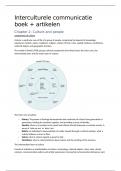Interculturele communicatie
boek + artikelen
Chapter 2: Culture and people
components of culture
Culture: a particular way of life of a group of people, comprising the deposit of knowledge,
experience, beliefs, values, traditions, religion, notions of time, roles, spatial relations, worldviews,
material objects and geographic territory.
The model of Dodd (1998): groups cultural components into three levels; the inner core, the
intermediate layer and the outer layer of culture.
The inner core of culture
- History: The power of heritage demonstrates the continuity of culture from generation to
generation, binding its members together and providing a sense of identity.
- Identity: Gives us a location in the world and reflects the link between us and the society. A
sense of ‘who we are’ or ‘who I am’.
- Beliefs: an individual’s representation of reality viewed through a cultural window. what a
culture believes as true or false
- Values: what a culture regards as good or bad.
- Worldview: what a culture believes about nature and the working of the universe.
The intermediate layer of culture
Consist of activities as manifestation of culture: technology, material objects, roles, rules, rituals,
customs, communication patters and artistic expressions. Nonverbal communication behaviour such
,as posture and gestures and concepts of time and space are also influences by culture (such as being
late is polite or bad).
Popular culture comprises the daily interactions, needs and desires that make up the everyday lives
of the mainstream, including practices pertaining to cooking, clothing, consumption, mass media,
sports and literature.
Folk culture refers to the localized lifestyle of culture. It is usually handed down through oral
tradition, and relates to a sense of community.
The outer layer of culture
Involves the institutions of culture. Institutions are the formalized systems including religion,
economy, politics, family, healthcare and education (the products of culture). The outer layer of
cultural systems handles numerous aspects of a culture’s survival in ways that are accepted and often
sanctioned by law.
Religion refers to any system of thought that provides answers to the big question of life, death, and
of life beyond death. It involves beliefs, ceremonies, worship, norms of respect and spiritual issues.
The cultural influences are reflected in family structure , such as family size
Characteristics of culture
Culture is:
- Holistic: culture functions as an integrated and complex whole.
- Learned: we learn cultural rules as we grow up from the sources like family, friends, teachers,
proverbs, adages and folk-tales.
- Dynamic: culture is a subject to change over time.
- Ethnocentric: the belief that one’s own culture is superior to other cultures.
Evaluate different approaches to studying culture
The emic approach views each culture as a unique entity that can only be examined by constructs
developed from inside the culture.
The etic approach assumes that culture can be examined with predetermined categories that can be
applied to all cultures in the search for cultural universals.
Define and analyse different types of subcultures
When we categorize cultures within dominant cultures by different groups of people, we refer to
these groups as subcultures. Subcultures can be categorized by activities, social class, gender,
ethnicity, race, geographic region, occupation, organization or even sexual orientation.
- Ethnic culture: ethnicity is frequently the basis of a subculture. Ethnic groups are identifiable
groups of people who are of common heritage and cultural traditions.
- Social class: Socioeconomic status (SES) can be the basis for a subculture. SES can be derived
from a person’s income, education, occupation, residential area and family background.
- Organizational culture: Subcultures also include organizational culture. Employees hold
beliefs, values and assumptions to organize their behaviour and interpret their experience in
the organization.
, - Regional culture: Geographic region is also a basis for categorizing people into subcultural
groups. Regional differences often imply differences in social attitudes, lifestyles, food
preferences and communication.
Explain discursive construction of culture and identify
Identity is a product of social construction. One important method of self-presentation is through
identification with a cultural group. Culture and identity are discursively constructed and socially
defined. Identity representation is shaped by social interaction.
Chapter 3: Communication and culture
Understand the multifaced nature of communication
Communication is sharing who we are and what we know. We all share our ideas and feelings with
others; however, how we share them with others varies from culture to culture.
New communication technologies create new configuration of sources, messages, and receives; they
also reinforce the need to examine existing definitions of communication.
Communication may be defined as the process by which people use shared verbal or nonverbal
codes, systems and media to exchange information in a particular cultural context.
The rhetorical tradition views communication as the practical art of discourse. A discourse approach
to communication holds the possibility that the practice of communication can be improved through
education and research.
Levels of communication
- Intrapersonal communication: the process of understanding and sharing meaning within the
self.
- Interpersonal communication: The process of understanding and sharing meaning between
at least two people when relatively mutual opportunities for speaking and listening exist.
- Group communication: Purposeful communication in limited-sized groups in which decision
making or problem solving occurs.
- Organizational communication: Communication in large cooperative networks including
virtually all aspects of both interpersonal and group communication.
- Mass communication: The process of understanding and sharing meaning with a broad
audience through mediated channels. Mass media like radio, television and newspapers are
specifically conceived and designed to reach a large audience.
components of communication
- Source:origin of information, sender of the message, someone who needs and wants to
exchange information with others.
Seeking information
Shared experiences
Given instructions
- Message: verbal and/or nonverbal form of the idea, thought or feeling one wishes to
communicate
- Channel: a means by which messages move from one person to another
- Receiver: intended target of the message
, - Encoding: the process by which the source uses shared codes to convert concepts, thoughts
and feelings into a message
- Decoding: the process by which the receiver converts the coded message back into meaning
- Noise: all factors that interfere with information transfer
Physical (distracting sounds or sights), psychological (nervousness) and semantic
(different interpretations of a concept)
- Feedback: the response of the receiver after receiving the message
Characteristics of communication
Communication is:
- A Dynamic process: meanings in communication are dynamic, continually changing as a
function of earlier usage and interpretation.
- Interactive: it requires the active participation of at least two persons.
- Symbolic: symbols can be verbal or nonverbal. Symbols are vehicles by which the thoughts
and ideas of one person can be communicated to another.
- Contextual: we interact with others in a specific setting.
Coordinated management of meaning theory
To improve patterns of communication. Whatever we do always intermeshes with the interpretations
and actions of other people.
Three goals:
1. To understand who we are, what it means to live a life, and how that is related to particular
instances of communication
2. To render cultures comparable while acknowledging their incommensurability
3. To generate an illuminating critique of cultural practices.
It is necessary to describe the cultural context if we are going to understand within and/or across
cultures. A person’s interpretation is also important.
Evaluate widely known models of communication
Communication models are representations of communication processes and characteristics – they
illustrate the main components of communication and their relationships to each other. When
communication theories need modification, so too do models.
The linear model






